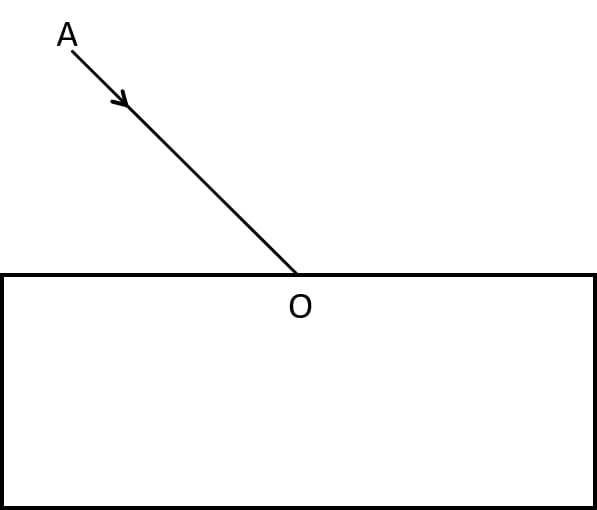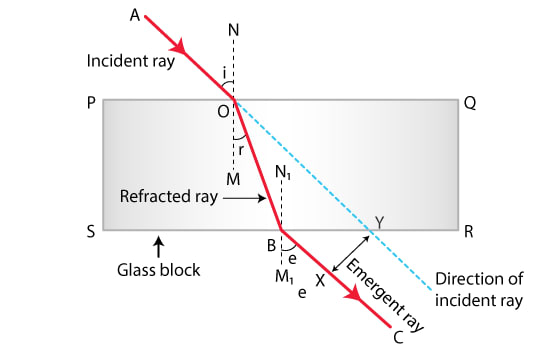Physics
In the adjacent diagram, AO is a ray of light incident on a rectangular glass slab.

(a) Complete the path of the ray until it emerges out of the slab.
(b) In the diagram, mark the angle of incidence (i) and the angle of refraction (r) at the first interface. How is the refractive index of glass related to angles i and r?
(c) Mark angle of emergence by the letter e. How are the angles i and e related?
(d) Which two rays are parallel to each other? Name them.
(e) Indicate in the diagram the lateral displacement between the emergent ray and the incident ray. State one factor that affects the lateral displacement.
Refraction Plane Surfaces
97 Likes
Answer
(a) The below diagram shows the path of the ray until it emerges out of the slab:

(b) In diagram, the angle of incidence (i) and the angle of refraction (r) are marked.
Refractive index of glass μ is related to the angle of incidence (i) and angle of reflection (r) by Snell's second law and is represented as —
The ratio of the sine of the angle of incidence i to the sine of the angle of refraction r is constant for the pair of given media
The constant 1μ2 is called the refractive index of the second medium with respect to the first medium.
(c) The angle of emergence (e) is marked in diagram.
As the refraction occurs at two parallel surfaces PQ and RS, therefore angle MOB = angle N1BO and by the principle of reversibility of the path of a light ray angle of emergence (e) is equal to the angle of incidence (i).
(d) As the refraction occurs at two parallel surfaces PQ and RS, therefore angle MOB = angle N1BO and by the principle of reversibility of the path of a light ray angle of emergence (e) is equal to the angle of incidence (i).
Hence, the emergent ray BC is parallel to the incident ray AO.
(e) The lateral displacement between the incident ray and the emergent ray is represented by XY.
One of the factors that affects lateral displacement is the the thickness of the medium. More the thickness of the medium more is the lateral displacement.
Answered By
66 Likes
Related Questions
What is lateral displacement? Draw a ray diagram showing the lateral displacement of a ray of light when it passes through a parallel-sided glass slab.
A ray of light strikes the surface at a rectangular glass slab such that the angle of incidence in air is (i) 0°, (ii) 45°. In each case, draw a diagram to show the path taken by the ray as it passes through the glass slab and emerges from it.
A ray of green light enters a liquid from air, as shown in the figure. The angle 1 is 45° and angle 2 is 30°.

(a) Find the refractive index of liquid.
(b) Show in the diagram the path of the ray after it strikes the mirror and re-enters in air. Mark in the diagram the angles wherever necessary.
(c) Redraw the diagram if plane mirror becomes normal to the refracted ray inside the liquid. State the principle used.
The speed of light in air is 3 x 108 m s-1. Calculate the speed of light in glass. The refractive index of glass is 1.5.